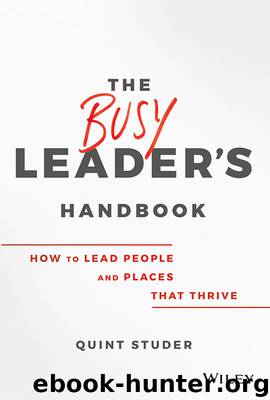The Busy Leader's Handbook by Quint Studer

Author:Quint Studer
Language: eng
Format: epub
ISBN: 9781119576679
Publisher: Wiley
Published: 2019-08-20T10:00:00+00:00
“What is something I can do as your supervisor to make sure this is a great place to work?”
“What are some areas you would like to be developed in?”
“What are some things you find demotivating?”
“Let me know what’s going well for you.”
“What energizes you?”
Pay attention to what they react to. Sometimes employees might not know how to articulate what their what is, or they might not be so forthright as to share it. Just pay attention and you can probably figure it out. What seems to excite them? What seems to frustrate them? Do their ears perk up when you start talking about a new and exciting project? Or do they seem more interested in hearing about the successful results of the project you just finished? What kind of situations and behaviors seem to get on their nerves? Noticing these patterns will help you identify their what, even if they might not realize it themselves.
Know that there may be more than one answer, and that it may change over time. People are often motivated by a variety of factors. Their most significant whats are likely to be pretty constant over time, but their secondary motivations may evolve based on things that are going on outside of the organization, as well as the pressures of their work environment. For example, if an employee is about to start a family, flexibility in their work schedule might start to be more important to them. They might prefer to travel less if possible. These desired changes may not always be doable but noticing them and making the effort to accommodate them really matter.
Write it down and share it with others. Most of the time you won’t be able to deliver on a person’s what on your own. You have to make it a team effort with others at every level of the organization. Once you are able to articulate a person’s what, share it with everyone that they work with, and make it clear that it matters to you as well. This is especially important in your interactions with customers.
When I worked in healthcare, we used Physician Preference cards. It was simply a card letting everyone know how a physician wanted to get information, where and when to contact them, when they prefer to round, etc. This helped nurses and other care providers develop effective working relationships with physicians.
Likewise, knowing your customers’ what will help you deliver on the things that matter most to them, and grow a relationship over time. Create a way to capture the customer’s what so others can also know it. This helps keep a customer when there is turnover in the organization. All these things make the employees’ life so much easier, too!
I found a great example of this at a barbershop that I frequent. They have many stylists, and customers rarely see the same one consistently. To make things easier on both the stylists and the customers, the shop created a system where stylists collect notes on how each individual customer likes their hair cut, with specifics and preferences.
Download
This site does not store any files on its server. We only index and link to content provided by other sites. Please contact the content providers to delete copyright contents if any and email us, we'll remove relevant links or contents immediately.
Hit Refresh by Satya Nadella(8338)
The Compound Effect by Darren Hardy(7558)
Change Your Questions, Change Your Life by Marilee Adams(6641)
Nudge - Improving Decisions about Health, Wealth, and Happiness by Thaler Sunstein(6633)
The Black Swan by Nassim Nicholas Taleb(6190)
Daring Greatly by Brene Brown(5640)
Deep Work by Cal Newport(5463)
Principles: Life and Work by Ray Dalio(5322)
Rich Dad Poor Dad by Robert T. Kiyosaki(5149)
The Myth of the Strong Leader by Archie Brown(4789)
Man-made Catastrophes and Risk Information Concealment by Dmitry Chernov & Didier Sornette(4735)
Big Magic: Creative Living Beyond Fear by Elizabeth Gilbert(4723)
The Slight Edge by Jeff Olson(4722)
Discipline Equals Freedom by Jocko Willink(4635)
Digital Minimalism by Cal Newport;(4540)
The Motivation Myth by Jeff Haden(4524)
Stone's Rules by Roger Stone(4415)
Management Strategies for the Cloud Revolution: How Cloud Computing Is Transforming Business and Why You Can't Afford to Be Left Behind by Charles Babcock(4130)
The Doodle Revolution by Sunni Brown(4043)
